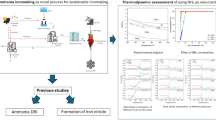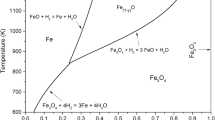Abstract
During the reaction of a pure metal with complex atmospheres containing both oxygen and sulfur, the formation of sulfide mixed with oxide is often observed at high temperature, contradicting thermodynamic predictions. The mechanism proposed so far to explain the formation of a duplex scale at the scale surface assumes a change in composition of the gas phase in a boundary layer next to the scale-gas interface and a reaction of the metal with the molecules of the two elements. This model is shown to be unable to explain the observed amounts of the less stable phase and the reaction rates when sulfur dioxide is the prevailing reacting species and is substituted by the assumption of a direct reaction with the SO2 molecules. The thermodynamic equivalence of the two approaches is also pointed out.
Similar content being viewed by others
References
N. Birks and N. Tattam,Corros. Sci. 10, 857 (1970).
T. Flatley and N. Birks,J. Iron Steel Inst. 209, 523 (1971).
M. R. Wootton and N. Birks,Corros. Sci. 12, 829 (1972).
G. Romeo and H. S. Spacil, inHigh Temperature Gas-Metal Reactions in Mixed Environments, S. A. Jansson and Z. A. Foroulis, eds. (Metall. Soc. A.I.M.E., New York, 1973), p. 299.
F. S. Petitt, J. A. Goebel, and G. W. Goward,Corros. Sci. 9, 903 (1969).
A. Rahmel,Corros. Sci. 13, 125 (1973).
A. Rahmel,Oxid. Met. 9, 401 (1975).
N. Birks, inHigh Temperature Gas-Metal Reactions in Mixed Environments, S. A. Jansson and Z. A. Foroulis, eds. (Metall. Soc. A.I.M.E., New York, 1973), p. 322.
S. Mrowec, J. C. Colson, G. Pawlowsky, and J. Podhorodecki,Bull. Soc. Chim. 11, 4103 (1972).
B. Chatterjee and A. J. Dowell,Corros. Sci. 15, 639 (1975).
P. Barret and B. Dupuisson,Rev. Int. Hautes Temp. Refract 14, 145 (1977).
C. B. Alcock, M. G. Hocking, and S. Zador,Corros. Sci. 9, 111 (1969).
A. Rahmel,Werkst. Korros. 23, 272 (1972).
T. K. Ross,Corros. Sci. 5, 327 (1965).
R. J. Hussey and M. Cohen,Corros. Sci. 11, 699 (1971).
P. Kofstad,High Temperature Oxidation of Metals (Wiley, New York, 1966), Chap. V.
Author information
Authors and Affiliations
Rights and permissions
About this article
Cite this article
Gesmundo, F. Mechanism of the simultaneous formation of oxide and sulfide at the scale surface during the oxidation of a pure metal in mixed atmospheres. Oxid Met 13, 237–244 (1979). https://doi.org/10.1007/BF00603668
Received:
Issue Date:
DOI: https://doi.org/10.1007/BF00603668




